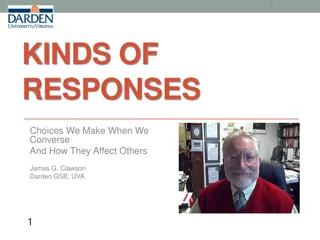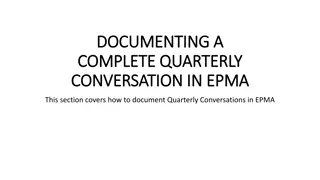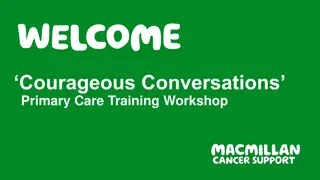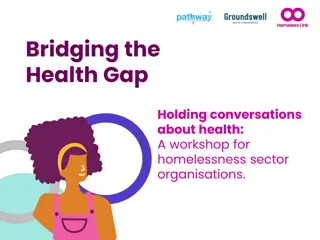Mastering Conversations in Healthcare: Strategies for Success
Explore the importance of effective conversations in healthcare settings, understanding the impact of crucial conversations on patient safety, quality of care, and staff commitment. Learn how to navigate difficult conversations around incompetence, broken rules, mistakes, and more to enhance communication and reduce medical errors.
Uploaded on Sep 21, 2024 | 2 Views
Download Presentation

Please find below an Image/Link to download the presentation.
The content on the website is provided AS IS for your information and personal use only. It may not be sold, licensed, or shared on other websites without obtaining consent from the author.If you encounter any issues during the download, it is possible that the publisher has removed the file from their server.
You are allowed to download the files provided on this website for personal or commercial use, subject to the condition that they are used lawfully. All files are the property of their respective owners.
The content on the website is provided AS IS for your information and personal use only. It may not be sold, licensed, or shared on other websites without obtaining consent from the author.
E N D
Presentation Transcript
Introductory Activity (15 mins) PART I: Why are Conversations important? (15 mins) Story Setting the Scene with 4Corners Episode Some interesting Stats PART II: What makes Successful/Effective Conversations? (1 hr) Films the Good, the Bad, and the Conversation Practice Action Learning PART III: How do I overcome Conversation Challenges? (45 mins) Tackling your own conversations My Action Plan for Practice (30 mins) Concluding Activity (10 mins) Post-workshop Evaluation (10 mins)
PART I: Why are Conversations Important?
Silence Kills Study (US, VitalSmarts, 2005) Focus groups, interviews, workplace observations and survey data from more than 1700 respondents 1143 nurses 106 physicians 266 clinical staff 175 administrators 13 urban, suburban and rural hospitals across the US Teaching, General and Pediatric Hospitals
Identified the categories of conversations that are especially difficult AND especially essential for people in healthcare -> These conversations correlated strongly with medical errors, patient safety, quality of care, staff commitment, employee satisfaction, discretionary effort, and turnover. Seven Most Crucial Concerns 1. Broken Rules 2. Mistakes 3. Lack of Support 4. Incompetence 5. Poor Teamwork 6. Disrespect 7. Micromanagement
Nurses and Other Clinical Care Providers Concerns about Incompetence 53% are concerned about a peer s competence This peer does something dangerous at least once a month (27%) The problem with this peer has gone on for a year or more (48%) A patient has been harmed by this person s actions during the last year (7%) 12% have spoken with this peer and shared their full concerns 34% are concerned about a physician s competence This physician does something dangerous at least once a month (19%) The problem with this physician has gone on for a year or more (54%) A patient has been harmed by this physician s actions during the last year (8%) Less than 1% have spoken with this physician and shared their full concern
Physicians Concerns about Incompetence 81% are concerned about a nurse s or other clinical-care provider s competence This peer does something dangerous at least once a month (15%) The problem with this peer has gone on for a year or more (46%) A patient has been harmed by this person s actions during the last year (9%) 8% have spoken with this peer and shared their full concerns 68% are concerned about a physician s competence This physician does something dangerous at least once a month (21%) The problem with this physician has gone on for a year or more (66%) A patient has been harmed by this physician s actions during the last year (19%) Less than 1% have spoken with this physician and shared their full concern
Nurses and Other Clinical Care Providers Concerns about Poor Teamwork 75% are concerned about a peer s poor teamwork This peer does something that undercuts the team at least once a month (61%) The problem with this peer has gone on for a year or more (69%) 16% have spoken with this peer and shared their full concerns Because of this teamwork issue, the respondent can t trust that patients in their area are receiving the right level of care (22%) Because of this teamwork issue, the respondent is seriously considering leaving the unit or the hospital (23%)
Nurses and Other Clinical Care Providers Concerns about Disrespect and Abuse 77% are concerned about disrespect they experience This person is disrespectful or abusive toward them in at least a quarter of their interactions (28%) The behaviour has gone on for a year or more (44%) 7% have spoken with this peer and shared their full concerns Correlation between the frequency of mistreatment and intent to quit their job (r=.424, p<.001) Correlation between the duration of abuse and intent to quit their job (r=.190, p<.001)
VitalSmarts conducted a further study in 2010 The Silent Treatment and showed that Organizational silence leads to communication breakdowns that harm patients. More than four out of five nurses have concerns about dangerous shortcuts, incompetence, or disrespect. More than half say shortcuts have led to near misses or harm. More than a third say incompetence has led to near misses or harm. More than half say disrespect has prevented them from getting others to listen to or respect their professional opinion. Fewer than half have spoken to their managers about the person who concerns them the most. And fewer than a third have spoken up and shared their full concerns with the person who concerns them the most.
The Impact of Errors in UK In national health service of England and Wales, mistakes or adverse events occur in 10% of inpatient admissions Human cost of these mistakes 40 000 lives and financial cost to service of over 2 billion pounds in additional care (Waring, 2005)
The Impact of Errors in US 1.5 million preventable adverse events (AEs) occur each year and claims that AEs occur in one third of hospital admissions 44,000 to 98,000 deaths occur each year due to medical errors More Americans die each year from medical errors than from motor vehicle accidents, breast cancer, or HIV/AIDS (Kalra et al., 2013)
The Impact of Errors in US 45 cents of every dollar spent in US related to medical mistakes One source claims the cost of errors in 2008 was over 17 billion 3.5 billion dollars per year are spent due to in hospital adverse drug events (ADE), which comprise roughly 26% of all preventable AEs according (Kalra et al., 2013)
The Impact of Errors in Australia Quality in Australian Health Care (QAHC) study (1995) - medical records for 14,000 admissions to 28 hospitals in NSW and SA 470,000 admissions/year associated with an adverse event (AE) -> approx. 18,000 deaths and 50,000 cases of permanent disability 50% of the AEs in the QAHC study had a high preventability score and 60% of deaths could have been avoided (Research Paper (19), CHE, Monash Uni, 2007)
The Impact of Errors in Australia The direct hospital costs of AEs, both fatal and non-fatal, was estimated in the QAHC study at $900 million per/year Another study estimated the cost of treating 12 conditions, representing just 22% of the AE categories, was $483 million/year 7% of routine admissions were associated with an adverse event (AE) in Victoria. (cw. estimates of 10-15% in QAHC study) (Research Paper (19), CHE, Monash Uni, 2007)
PART II: What makes Successful/Effective Conversations?
What kinds of Challenging Conversations do Clinical Supervisors have? (Flipchart)
What makes these Challenging Conversations Successful/Effective? (Flipchart)
Skills for Patient Conversations Skills for Supervisory Conversations
Debrief Act Observe Plan Film 2 Act Reflect Conclusions Observe Plan Act Reflect Observe Plan Reflect Debrief Film 1 Trio (Supervisor, Junior, Observer) swap roles for each cycle
Film 1 Observe what s being done well? Does it work? Body language Questions Evidence of listening Impact on junior response Intention Consequences
Debrief What do you think is going on for the junior nurse/doctor? What tells you this? What do you think is going on for the supervisor? What do you think the supervisor s intention is? What do you think happens next? What s at stake? i.e. consequences of having/not talking about what s happened? Debrief in Trio Debrief in Large Group
PRACTISE in trios one person plays takes on the supervisor role, one person takes on the junior role, the third person observes. (5mins) OBSERVE the Interaction: Supervisor: notice what happens physically when you have the conversation. Share you purpose/intention with the observer before you begin. Junior: respond how you would respond if you re in the conversation for real. Observe what you re reacting to. Observer: watch body language from both parties and notice what s going well/not so well. Talk about observations (3 mins) PLAN the conversation you would have if you were the supervisor in this situation. Start with INTENTION/PURPOSE what do you want to happen as a result of this conversation? Record Intention (3mins) Act Observe Plan Reflect Reflect on Intention: share intention and check to see if this was fulfilled (2mins)
Debrief What worked? What did not work? What are the consequences? Debrief in Large Group
Film 2 Observe what s being done well? Why does it work? Body language Questions Evidence of listening Impact on junior response Intention Consequences
What makes Successful/Effective Conversations? Draw Conclusions in Large Group (Flipchart)
PART III: How do I overcome Conversation Challenges?
What makes Challenging Conversations hard? (Flipchart)
Consequences of having challenging Conversations What if I do? What if I don t? 1. 2. 3. 4. 5. 1. 2. 3. 4. 5. Discuss in Trio Discuss in Large Group
When the Concern is Percentage Saying It Is Difficult to Impossible to Confront the Person Incompetence 56% of Physicians 72% of Nurses and other Clinical- Care Providers Poor Teamwork 78% of Nurses and other Clinical- Care Providers Disrespect or Abuse 59% of Nurses and other Clinical- Care Providers
When the Concern is Percentage of Non- Supervisory Employees Who Confront the Person Percentage of Supervisors Who Confront the Person Competence of a Nurse or other Clinical-Care Provider 3% 16% Competence of Physician Less than 1% Less than 1% Poor Teamwork 5% 9% Disrespect or Abuse 2% 5%
Consequences of having challenging Conversations What if I do? What if I don t? 1. 2. 3. 4. 5. 1. 2. 3. 4. 5. Discuss in Trio Discuss in Large Group
THINK ABOUT A CONVERSATION YOURE AVOIDING HAVING What s stopping you? What would happen if you could have this conversation (for the other person, for you, for patients, the rest of the team?) What will happen if you don t have the conversation? (for the other person, for you, for patients, the rest of the team?) Imagine you are committed to having the conversation - what is your intention/purpose in having this conversation?
FISH BOWL Supervisor Junior (played by facilitator) Debrief Swap Roles Debrief
VOX POP 1. Listen to what students have to say about the experience of clinical supervision 2. Listen to the perspectives of the actors
Post Card: My Action Plan for Practice What s one thing you will commit to that will make a lasting difference ?
Concluding Activity (cw: Intro Activity)
Ms Tanya Edlington tanyaedlington@gmail.com Tanya Edlington Pty Ltd Melbourne Australia A/Prof Brett Williams brett.williams@monash.edu Head of Department Faculty of Medicine, Nursing and Health Sciences Monash University Dr Christine King christine.king@monash.edu Learn to Learn Brisbane, Australia























